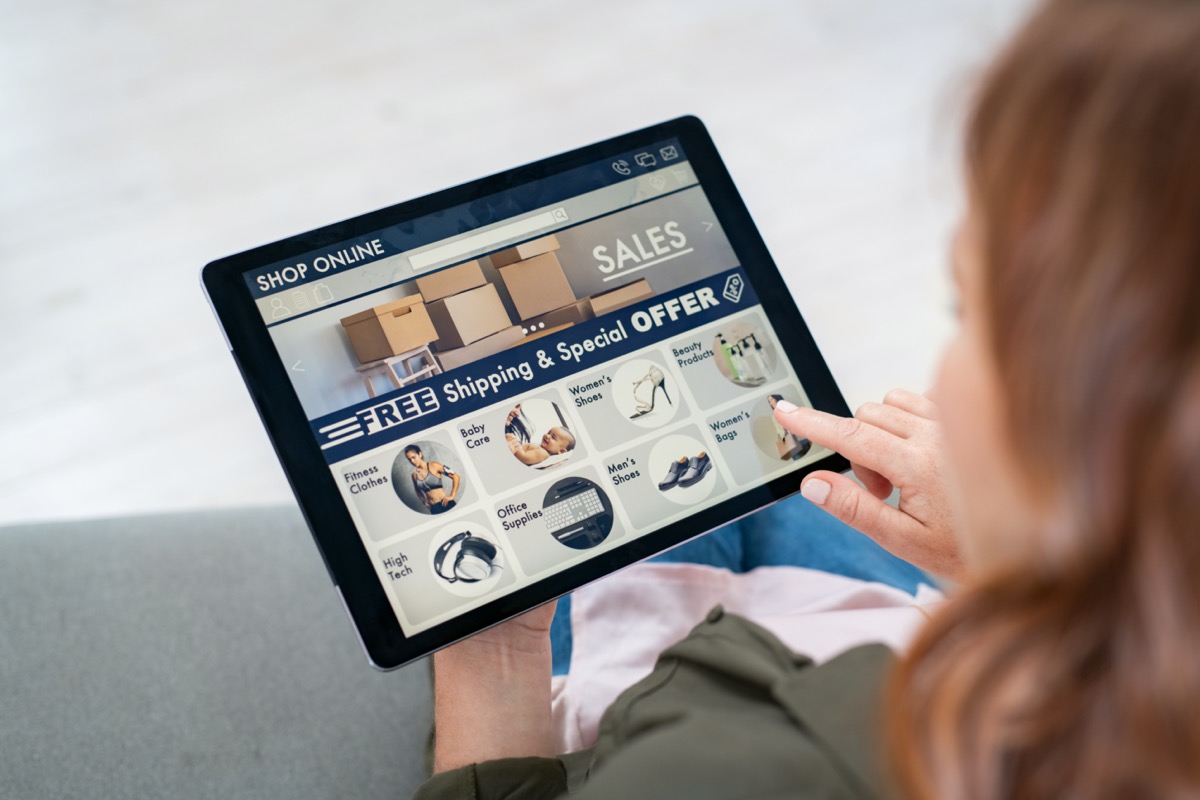Sneaky Ways Retailers Are Tricking You to Overspend Right Now

With the coronavirus pandemic continuing to spread into the colder months and the holidays fast approaching, your favorite retailers are coming up with an increasing number of clever tricks to get you to overspend your hard-earned cash right now—in both their brick-and-mortar stores and online. Have you ever walked into Target just to get a tube of toothpaste or a few rolls of paper towels and you walked out an hour later with your wallet $100 lighter? If so, you know exactly what we’re talking about. If you want in on their tricks so you can have willpower against them, read on. And for more ideas on what to buy this holiday season, Here Are Oprah’s Favorite Things of 2020 Under $50.
Read the original article on Best Life.
1
The free shipping game

Online retailers are notorious for using the free shipping carrot to get you to overspend, but it’s a trick you shouldn’t fall for. Because here’s the thing: The store will undoubtedly provide free shipping after you spend a certain amount.
You may only need a $20 item, but you need to get to their $50 minimum to get the free shipping. The free shipping tactic pushes you to buy more to save a few bucks on the shipping costs. And for a way to get money back faster for online returns, here is The New Way You Can Instantly Get Your Money Back After a Return.
2
A welcome discount

When you first visit a website, often there is an immediate pop up to take advantage of a one-time sale or deal. These welcome discounts are notorious tricks for getting you to overspend and usually involve a certain percentage off of your order.
If the deal is 15 percent off your order, this subconsciously pushes you to add a few more items to the cart because of the deal. If you stick to purchasing what you really need, you’ll be sure to save money. And for more tips on what’s the best way to shop, check out 33 Holiday Shopping Dos and Don’ts From Retail Experts.
3
Additional items you may like

There is always a section with additional or recommended items displayed for you during the online checkout process. This is a last-ditch effort by online retailers to entice you to continue browsing their products. They purposefully show items similar to the items in your virtual cart that complement your items or are closely related to encourage you to take a second look. Avoid this sales tactic by sticking with what you chose and avoiding the additional suggestions. And for more online scams you shouldn’t fall for, check out 17 Ways You’re Making Yourself a Target for Scammers.
4
Essentials are at the back of the store

Think about the things you need. Where are they located in the store? You have to walk to the back, right? And what do you do while you walk there? Unless you have your eyes closed, you look around and get tempted. Suddenly, there are things in your cart that you never intended to buy, but they “chose you” as you walked by.
For instance, two major retailers, Target and Walmart, use special “end caps” to showcase special deals or sales. These end caps are at the very end of each row, pointed towards the main aisles. As you walk to your intended destination, you will usually walk by a dozen or so end caps with discounted items.
The placement of these end caps is a strategic trick intended to get you to overspend. And for more on shopping stores like these, check out 15 Money-Saving Tricks Only Walmart Insiders Know.
5
Carts are at the front of the store

Grocery stores need carts, of course. But retail stores? They have carts simply to get you to spend more. Most people could probably get by with a handheld basket, but because the carts are the first thing you see, that’s what you’ll grab and fill. This results in spending more than you intended. Also, some stores even have larger carts than usual, which will leave more room for spending more money. So resist the urge to fill that cart!
6
Splurge items are at eye level

The healthy, on sale, or low-profit items, are usually higher or lower than eye level. That’s not what retailers want you to see, so they make you reach or bend over for them.
Instead, they want you to buy what grabs your attention. What they put at eye level are the items that make them the most money—the things you probably didn’t plan to buy, but they land in your cart anyway. And for more retail tips you can use, sign up for our daily newsletter.
7
Sales with a twist

You see a sale, and you have to have it, right? Retail stores know this, so they structure their deals so you overspend. They don’t just run X-percent-off sales. Sure, that might make you buy something, but you probably won’t spend more.
But, a “Buy One Get One Free” sale or “10 for $10” deal, for example, gets you to buy more. You think, “Well, if it’s free, why not, right?” You probably don’t even look at the price or what you would spend or save if you only bought one. Typically, you spend more money when taking advantage of these sales.
8
Retailers make their stores comfy

We all have our favorite stores. You walk in and feel at home. Retail stores make you feel this way for a reason. They play music customers love, create a trendy atmosphere, or create displays that make you wander down the aisles.
Before you realize it, you’ve spent more time in the store than intended, and what happens when you spend more time in a store? You spend more money. And for more on retail stores that have been suffering lately, 10 Beloved Strip Mall Stores You May Never See Again.
9
They have loyalty programs

Which store are you most likely to patronize—the one without a loyalty card or the one with a card? That loyalty card makes you feel like a VIP, right? It’s like you’re in on a big secret, and only you know about it.
You’ll likely overspend at stores you have a loyalty card at because while you’re shopping, you think, “Well, I get 5 percent off, so I can splurge on this, or buy this product I didn’t need.” That loyalty program lulls you into a sense of security and exclusivity, allowing you to spend money you probably wouldn’t have spent otherwise.
10
Displays right when you walk in

Retail stores know you’re more likely to throw unnecessary items in your cart right when you walk in, so they put displays right up front. If they put them toward the back when you have a full cart, you’re more likely to think twice about the purchase. When you’ve just walked in and haven’t grabbed anything yet, though, there’s plenty of room for splurging.
Keep your wits about you when shopping, especially during the holiday season. Make a list and stick to it. Don’t shop when you’re tired or emotional. Know your budget and stick to the 48-hour rule. If you see something that isn’t on your list that you want, step away for 48 hours. If you still want it after then, figure out how to pay for it. This way, you’ll plan for the purchase rather than haphazardly spending and putting yourself in debt. And if you want to learn about some more holiday sales, This Is the Best Deal from Target’s Black Friday Now Sale, Experts Say.